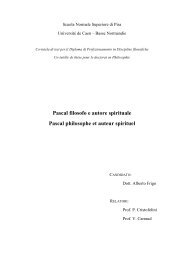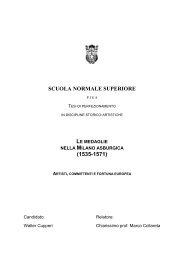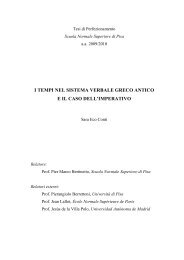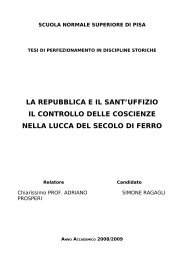CATULLUS 68 - Scuola Normale Superiore
CATULLUS 68 - Scuola Normale Superiore
CATULLUS 68 - Scuola Normale Superiore
You also want an ePaper? Increase the reach of your titles
YUMPU automatically turns print PDFs into web optimized ePapers that Google loves.
Morgan is a separatist, while Lachmann, Schmidt, Kroll and Mynors are unitarians; they also have to<br />
account for the alternate use of the praenomen and the gentilicium within the same poem. Within the<br />
surviving body of Latin poetry there is only one possible parallel, Ovid’s ex Ponto 4.1, where the<br />
poet addresses Sextus Pompeius first as Pompeius and as Sextus (lines 1f. Accipe, Pompei, deductum<br />
carmen ab illo, / debitor est uitae qui tibi, Sexte, suae) and then only as Sextus (line 35 sic ego pars<br />
rerum non ultima, Sexte, tuarum). 48 But Ovid’s strategy there is significantly different from the one<br />
used here by Catullus according to Lachmann. Ovid uses first the praenomen and the gentilicium,<br />
which identify the addressee, and then the praenomen alone, to achieve variation, intimacy or both.<br />
We have no poems in which a man is addressed now by his praenomen and then by his gentilicium,<br />
and in prose it is extremely rare: the only example may be Cicero, pro Quinctio 37-40, where Sextus<br />
Naevius is addressed now as Sexte and then as Naeui. 49<br />
In Lachmann’s reconstruction of the poem praenomen and gentilicium are used indiscriminately: we<br />
have the more formal gentilicium in lines 41 and 50 in close company with the familiar praenomen<br />
in line 66 (and also in line 30, but that passage has a very different tone). This is mitigated in the<br />
variant proposed by Bernhard Schmidt, in which forms of the praenomen are reconstructed only in<br />
lines 11 and 30. In that case the praenomen would be banished from the more elevated central<br />
section of the poem (lines 41-148) to the informal introduction (lines 1-40). However, the metre calls<br />
for the vocative of the gentilicium Allius also in line 150 in the informal epilogue (lines 149-160),<br />
which thus cannot stand in true symmetry with the introduction, as a unitary reading would require.<br />
Even Schmidt’s variant leads to an inconsistency in tone between different parts of Catullus <strong>68</strong>. It<br />
could be salvaged if we interpreted Catullus <strong>68</strong> with Ellis as two different poems (1-40 and 41-160)<br />
written on different occasions, but concerned with the same person, who is addressed by his<br />
praenomen in the first poem and is referred to by his gentilicium in the second. However, there do<br />
not appear to be any grounds for identifying the friend addressed in lines 1-40 with the friend praised<br />
and addressed in lines 41-160 other than the possible unity of the poem.<br />
To sum up, Lachmann’s idea that the addressee was called Manius Allius and that Catullus<br />
addressed him and referred to him alternately by his praenomen and by his gentilicium does not<br />
work. Address by the praenomen alone is not found anywhere else in Catullus and only rarely in<br />
Roman poetry. The alternation between the praenomen and the gentilicium is even more rare, and it<br />
would appear to imply changes of tone that simply cannot be detected within the text.<br />
48<br />
Helzle 1989: 44 suggests that the introductory combination of praenomen and gentilicium is analogous to the form<br />
with which Cicero introduces his essays that he dedicates to his friends, and that in line 44 „[p]resumably Ovid uses<br />
Pompeius’ praenomen because he did not have a cognomen”. Perhaps Ovid simply needs to identify his friend, and he<br />
wants to avoid using the fateful name Pompeius.<br />
49<br />
See n. 44 above.<br />
25






